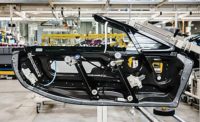The General Motors’ Orion Assembly Plant sits in the shadow of a large landfill. But, the 4-million-square foot factory, which is home to the Chevrolet Sonic and the Buick Verano, uses that to its advantage. The plant derives a significant portion of its power from landfill gas.
The nearby Eagle Valley Landfill, which has been in operation for several decades, is owned by Waste Management Inc. It handles the solid waste needs of Oakland County residents and businesses.
Every day, decomposing waste creates thousand of cubic feet of landfill gas, which provides methane that is captured and used as a green energy source. Landfill gas from Eagle Valley, and another local landfill, helped GM virtually eliminate the burning of coal at the Orion Assembly Plant.
The factory has used landfill gas since 1999. It saves GM more than $1 million annually in energy costs, and was a contributing factor in the decision to keep the Orion plant operating during the company’s recent restructuring.
The use of the landfill gas cuts the amount of greenhouse gases, sulfur dioxide and nitrogen oxides released in the air. During most of the year, the system runs exclusively on landfill gas primarily to generate steam for heating and compressed air. This saves more than 6,300 tons of CO2 from entering the atmosphere.
Currently, it helps heat a portion of an upgraded paint shop that uses half the energy per vehicle as the one it replaced. And, thanks to a recent electric-generation project, 54 percent of Orion’s energy now comes from renewable landfill gas.
“Orion is a great example of the latest technologies employed by GM manufacturing around the globe,” says Eric Stevens, GM vice president of global manufacturing engineering. “Use of landfill gas is just one of the sustainable methods that lessen the plant’s environmental impact.”
Other green manufacturing initiatives at the Orion assembly plant include lighting system upgrades that have saved $575,895 while also cutting CO2 by 5,003 metric tons. The one-time saving was equivalent to the energy used by 442 homes.
Orion engineers track energy use on an hourly basis with sophisticated software, which enables them to see real-time usage by department to improve their equipment shut-down activities.
Some packaging material is diverted back to the cars being made on the Orion assembly line. For instance, recycled cardboard, in addition to used denim, are part of the Verano’s sound insulation.
“Environmentally friendly choices often translate to higher efficiency and quality,” says Maureen Midgley, GM executive director of global manufacturing engineering. “Our new Orion paint shop [for instance] was designed for optimal efficiency and delivers premium paint appearance for our vehicles.” The eco- paint process eliminates the need for a primer oven, which reduces energy consumption and emissions.
“With these improvements, we’ll reduce greenhouse gas production by about 80,000 metric tons at a full three-shift capacity,” claims Midgley. “This is equivalent to the emissions from 14,000 vehicles per year, and the electricity reduction equals the output from 3,500 homes.”
In addition, the Orion plant is a leader when it comes to solar power. A two-acre solar array next to the factory generates 350-kilowatts of electricity, which is sent back to the grid by DTE Energy for use by local homes and businesses. The project saves the equivalent of 261 metric tons of CO2 from entering the atmosphere.
“Last year, we committed to doubling our global solar output at our facilities from 30 megawatts to 60 by 2015,” says Mike Robinson, GM vice president of sustainability and global regulatory affairs. “We believe in harnessing energy from clean, renewable sources because there is a solid business case to be made and it’s good for the environment. This array reinforces our progress.”
The array is part of DTE Energy’s SolarCurrents pilot program that calls for the installation of photovoltaic systems on customer rooftops or property during the next three years. The goal is to generate 15 megawatts of electricity throughout Southeast Michigan.



